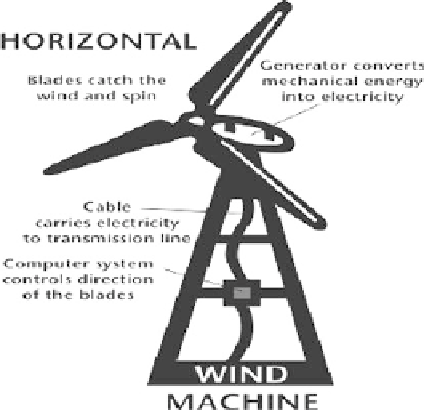Agriculture Reference
In-Depth Information
basic two or three bladed turbine is widely used. The rotation of the blades spins a
turbine. Turbines are used in almost all electrical generating technologies. Within
the turbine, there are magnets whose rotating motion causes an electrical field, and
we get a current flow. The generated electricity can be used at any area for irrigation
water pumping.
A wide range of generating capacities allow wind turbines to fill a wide range
of applications and sites. Individual producers, generating electricity for their own
home needs may use a turbine as small as 10 kW (this would power one hundred
100 W light bulbs at peak power). Larger utility-based wind farms may use turbines
from 50 kW all the way up to 2 MW (1 MW
=
1,000 kW). The typical sizes for
modern utility applications are between 200 and 300 kW.
13.5.10 Working Principle of Wind Machines
Like old-fashioned windmills, today's wind machines use blades to collect the
the blade acts much like an airplane wing. When the wind blows, a pocket of low-
pressure air forms on the downwind side of the blade. The low-pressure air pocket
then pulls the blade toward it, causing the rotor to turn. This is called lift. The
force of the lift is actually much stronger than the wind's force against the front
side of the blade, which is called drag. The combination of lift and drag causes
the rotor to spin like a propeller, and the turning shaft spins a generator to make
electricity.
Fig. 13.4
Schematic view of
a wind machine

Search WWH ::

Custom Search